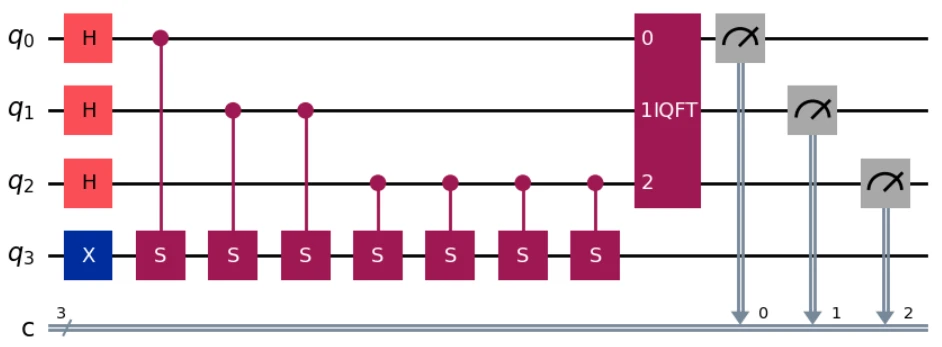Quantum Phase Estimation with Qiskit 2.0
In the previous articles, we covered the following topics:
- Understanding Quantum Fourier Transform Through Concrete Examples
- Inverse Quantum Fourier Transform with Qiskit 2.0
- Inverse Quantum Fourier Transform with the Amazon Braket SDK
- Quantum Phase Estimation with the Amazon Braket SDK
In this article, we will implement Quantum Phase Estimation with Qiskit 2.0.
Amazon Braket Learning Course
You can efficiently learn the basic knowledge of quantum computing—including quantum gates and quantum circuits introduced in this article—as well as how to use Amazon Braket through this course.
This course is designed for those with no prior knowledge of quantum computing or AWS, and by the end, you’ll even be able to learn about quantum machine learning. Take advantage of this opportunity to build your skills in quantum technologies!
Quantum Phase Estimation with Qiskit 2.0
In this example, we’ll use the $S$ gate as the target unitary matrix and $\ket{1}$ as its eigenstate. In other words, we aim to estimate the eigenvalue of the $S$ gate with respect to $\ket{1}$ using Quantum Phase Estimation. While it might be possible to compute this eigenvalue mentally, let’s pretend we don’t know it and proceed with the implementation. First, we’ll import the necessary functions.
from qiskit import QuantumCircuit
from qiskit.primitives import StatevectorSampler
from qiskit.circuit.library import QFT
from qiskit.circuit.library import SGate
Let’s define the sampler.
sampler = StatevectorSampler()
Let’s define the quantum circuit. In this example, we set the number of qubits in the readout register to 3.
n_qubits = 4
n_readout_qubits = n_qubits - 1
qc = QuantumCircuit(n_qubits, n_readout_qubits)
As explained in previous article, we can apply Hadamard gates to the qubits in the readout register based on the theory.
for qubit in list(range(n_readout_qubits)):
qc.h(qubit)
Additionally, the fourth qubit, which is the last qubit, is prepared in the eigenstate $\ket{1}$.
qc.x(n_readout_qubits)
Next, we apply the controlled-$S$ gate. As shown in previous article, note that the controlled-$S$ gate must be applied $2^{n-1}$ times depending on the qubit.
ctrl_s = SGate().control(1)
for ctl_bit in list(range(n_readout_qubits)):
for i in list(range(2**(ctl_bit))):
qc.append(ctrl_s, [ctl_bit, n_readout_qubits])
Next, we will perform the inverse Quantum Fourier Transform, but before that, let’s take a moment to review.
When executing QFT(num_qubits=3, inverse=True, do_swaps=True).decompose().draw('mpl'), the inverse Quantum Fourier Transform for 3 qubits results in the following circuit:

Since the state of the readout register needs to be arranged according to the order of this transformation, we don’t apply SWAP gate this time.
iqft = QFT(num_qubits=n_readout_qubits, inverse=True, do_swaps=True)
qc.append(iqft, [0, 1, 2])
qc.measure([0, 1, 2], [0, 1, 2])
When implementing the Quantum Fourier Transform and its inverse, it is important to pay close attention to the order in which operations are applied. In this case, by constructing the inverse Quantum Fourier Transform circuit while taking into account the pattern of controlled-$S$ gates applied to each qubit, we can obtain the expected result.
Printing the circuit by qc.draw('mpl') yields the following:

Now, let’s execute the quantum circuit.
pub = (qc, None)
job = sampler.run([pub], shots=1024)
result=job.result()[0]
print(result.data.c.get_counts())
# Output
# Counter({'010': 1024})
By measuring only the readout register, we obtain 010. Since the number of qubits in the readout register was $3$, this means that $\phi = 2/2^3 = 1/4$ was estimated by this circuit.
In other words, the eigenvalue of the $S$ gate with respect to $\ket{1}$ is estimated as $e^{2\pi i \phi} = e^{\pi i /2}$. This is indeed consistent with the theoretical expression below.
Quantum phase estimation has been successfully executed!
$$ S |1\rangle = \begin{bmatrix} 1 & 0 \\ 0 & e^{i\pi/2} \end{bmatrix} \begin{bmatrix} 0 \\ 1 \end{bmatrix} = e^{i\pi/2} |1\rangle $$
Amazon Braket Learning Course
You can efficiently learn the basic knowledge of quantum computing—including quantum gates and quantum circuits introduced in this article—as well as how to use Amazon Braket through this course.
This course is designed for those with no prior knowledge of quantum computing or AWS, and by the end, you’ll even be able to learn about quantum machine learning. Take advantage of this opportunity to build your skills in quantum technologies!
